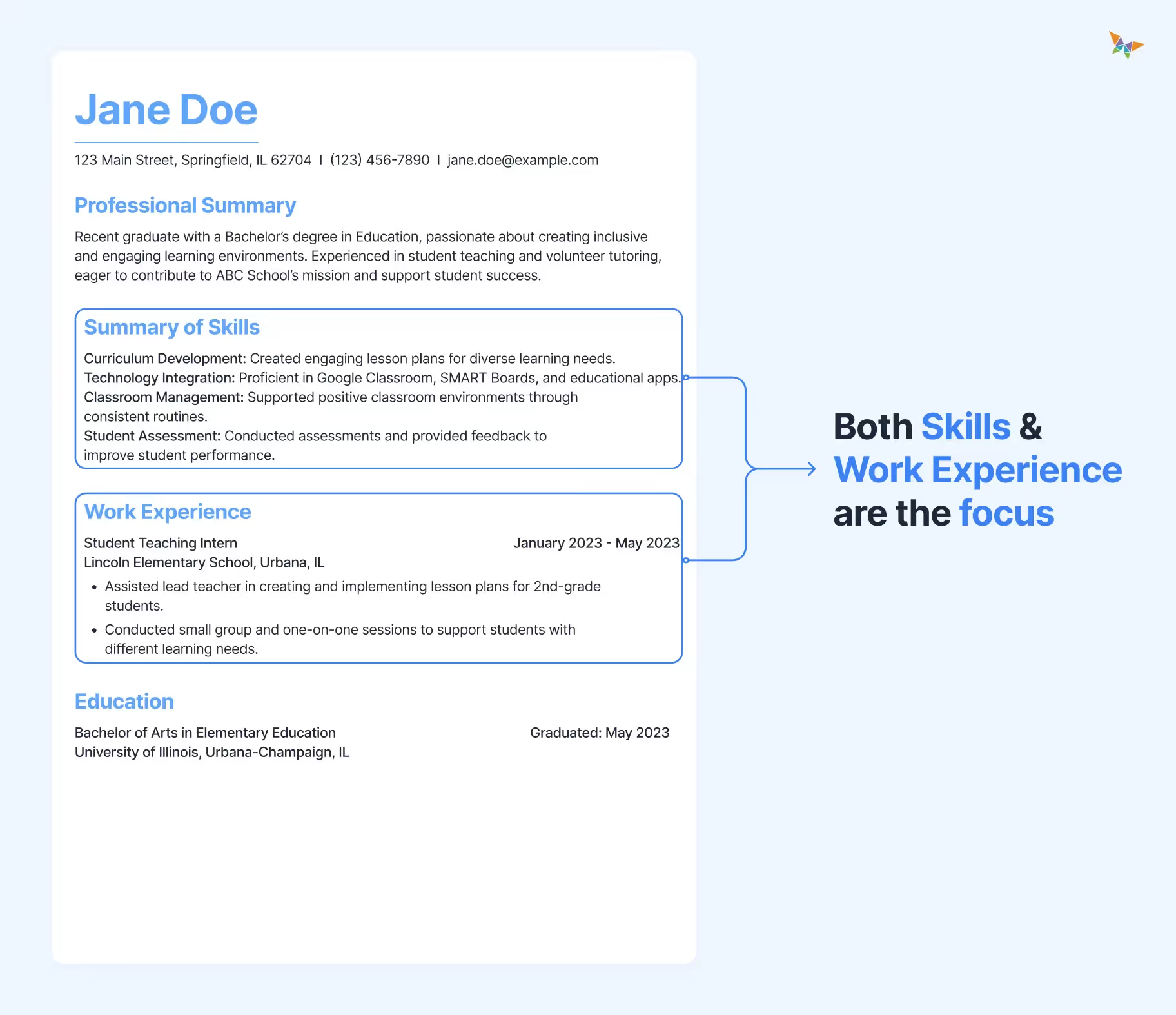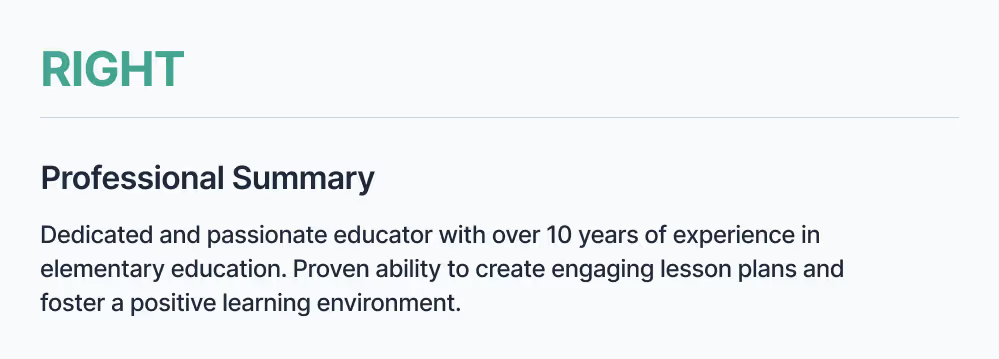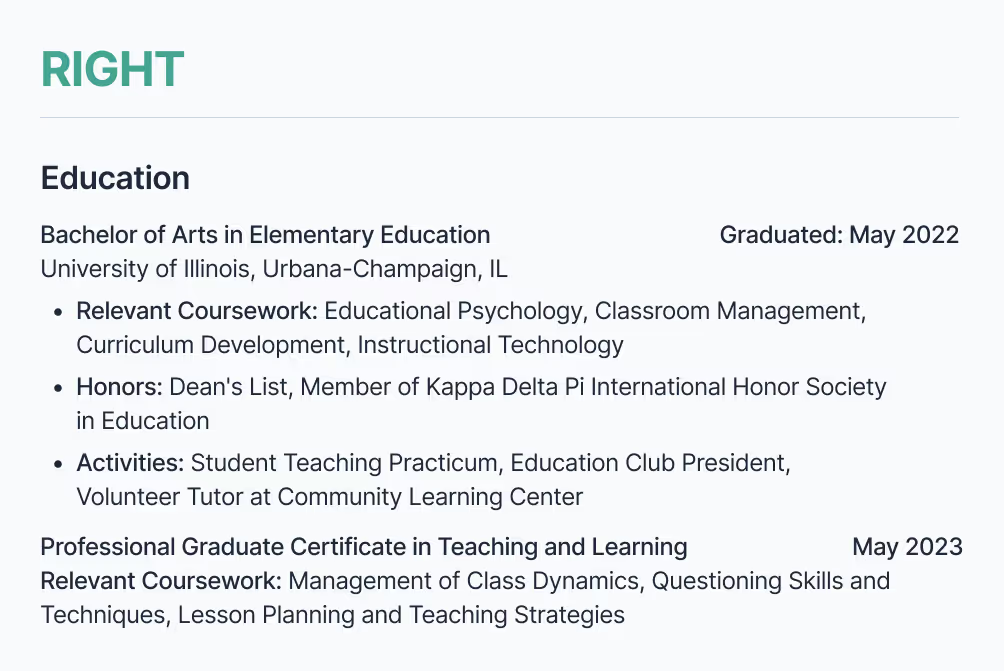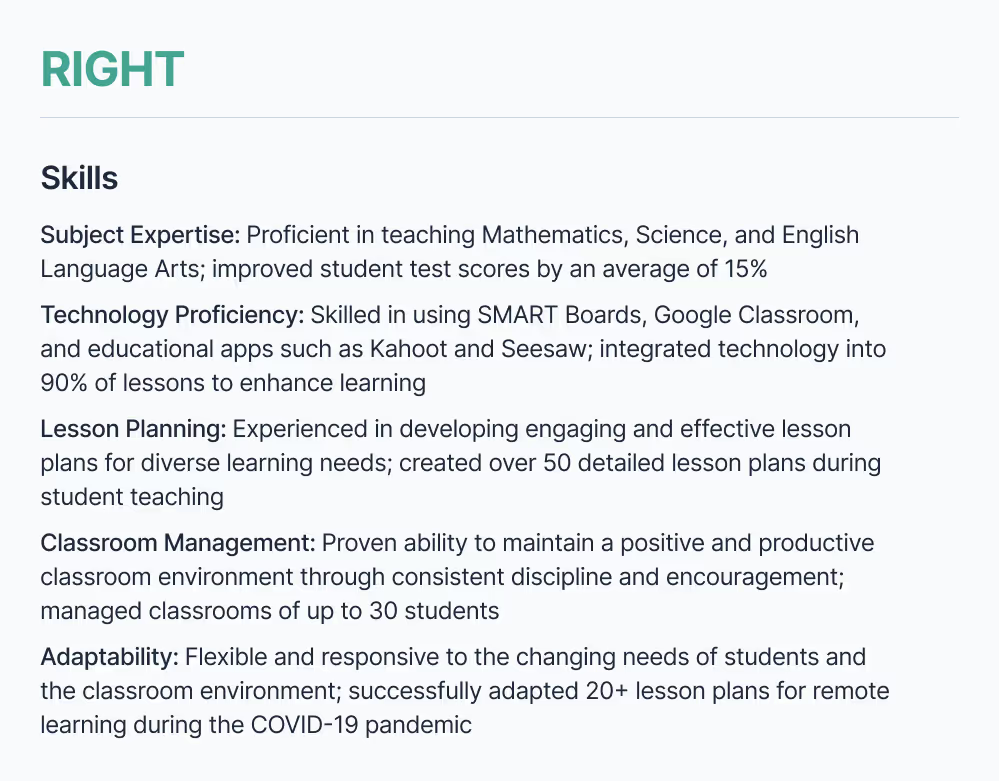Six seconds.
That's all the time you have to capture a recruiter's attention with your teacher resume.
Think about it—six seconds is barely enough time to glance at the clock or answer a student's brief question.

Yet, in those moments, your resume must quickly show you’re the right fit to avoid rejection.
Many schools use Applicant Tracking Systems (ATS) to filter resumes before a human even sees them. So, it's crucial to have an ATS-friendly resume. How can you ensure your teacher resume stands out?
This blog is your key to creating an ATS-friendly teacher resume that stands out among dozens or even hundreds of applications.
Here’s what we’ll cover:
- Formatting and Design Tips for a Teacher Resume
- Essential Sections of a Teacher Resume
- Teacher Resume Templates/Samples
- Writing Job Application & Preparation Tips For Teacher Interviews
By the end of this blog, you'll have all the tools and knowledge to craft the perfect teacher resume.
Let’s begin with understanding the different resume formats and choosing the right resume format for teacher jobs.
To start with, it’s important for you to understand why your teacher resume format matters. It’s not just about making your teacher resume look ‘pretty’.
It’s about making sure your resume gets read by both humans and ATS (Applicant Tracking System) scanners. If your teacher resume isn’t formatted correctly, it might never even be seen by a recruiter. Sounds scary, right?
Don’t worry, though. With the right format, you can ensure your resume passes the initial scans and reaches decision-makers.
Choosing the Right Teacher Resume Format
Here are some tips for choosing the right format for your teacher resume and the message you want to convey:
a) Chronological Format: This format lists your work experience in reverse chronological order, starting with your most recent job.
🎯 Ideal for you if:
- you have a steady and consistent work history
- have been teaching for several years and have no significant employment gaps

b) Functional Format: This format focuses on your skills and qualifications rather than your chronological work history.
🎯Ideal for you if:
- you are changing careers or have gaps in your employment history
- allows you to showcase your relevant skills and competencies

c) Combination Format: As the name suggests, this format combines elements of both the chronological and functional formats. It highlights your skills and qualifications at the top, followed by a detailed work history.
🎯Ideal for you if:
- you are experienced and want to emphasize both your skills and extensive work history

Now that we’ve covered the teacher resume formats, let’s move on to design tips to ensure your resume is polished and professional.
Design Tips for a Teacher Resume
.avif)
Having a clean and professional design can make a big difference in how your resume is perceived. Here are some easy tips to help you achieve that:
- Keep It Simple and Professional: Use a clear, easy-to-read font like Arial or Times New Roman. To ensure readability, stick to a font size between 10 and 12 points.
- Use Bullet Points: Break down information into bullet points. This makes it easier for recruiters to quickly scan your teacher resume and find key details.
- Incorporate White Space: Avoid clutter by leaving enough white space around text and sections. This makes your teacher resume look neat and organized, making it easier to read.
- Ensure Consistent Headings and Formatting: Ensure that all your headings are consistent in style and format. This helps create a cohesive and professional appearance.
- Save Your Resume as a PDF: This ensures the format stays consistent across different devices and platforms.
- Name Your File Clearly: Use a clear file name, e.g., Firstname_Lastname_Resume.pdf. This makes it easy for recruiters to identify your document.
- Keep It Concise: Aim for a one-page resume. If you have extensive experience, a two-page resume is acceptable but try to be concise.
- Align Text to the Left: This makes your resume easier to follow and more professional in appearance.
- Use 1-Inch Margins: This ensures your resume is not too crowded and looks clean and organized.

By following these tips, you can create a resume that looks good and communicates your qualifications effectively.
With a strong understanding of formatting and design, let's explore the essential sections that every teacher resume should include. These sections ensure your resume covers all necessary information comprehensively.
This section will cover detailed teacher resume examples for each section to provide you with the clarity to craft the perfect resume.
By the end of this section, you'll be ready to build an effective resume & land your dream teaching job. Let’s start with the first section of your teacher resume.
Section 1: Personal Details
The personal details section is located right at the top of your resume. It’s the first thing recruiters will see, so it’s important to get it right.
Usually, the following details are covered in this section:
- Full name- Use your full name as it appears on your professional documents.
- Contact Information- Provide your phone number and a professional email address.
- LinkedIn profile link- Ensure your LinkedIn profile is up-to-date with your latest experiences and endorsements.
- Current location- Include your city and state to give recruiters an idea of your geographical location without needing your full address.
Here’s a teacher resume example for this section-

What's wrong with it?
- The address is too vague.
- The phone number lacks formatting.
- There's no email or LinkedIn profile.
Instead, go for something like-

Why does this work?
- Provides a complete and clear location.
- The phone number is formatted for easy reading.
- Includes a professional email and LinkedIn profile, ensuring easy and professional communication.
With your personal details correctly presented, you’re already making a strong first impression. Let’s move on to the teacher resume summary.
Section 2: Teacher Resume Summary
The resume summary is a brief statement that highlights your professional background, skills, and career goals.
It’s located near the top of your resume, just after your personal details. This section should immediately convey your value as a candidate.
A teacher resume summary should include:
- Your current job title: This immediately tells the recruiter your current role and gives context to your experience.
- Years of experience: Highlighting your experience quickly establishes your level of expertise.
- 1 or 2 Key Accomplishments or Responsibilities: Showcasing your achievements or main responsibilities provides evidence of your capabilities.
- Your Desired Goal: Mentioning your passion for working at a specific school or organization indicates your career aspirations and alignment with the job.
Let’s look at an example-

What's wrong with it?
- Lacks specific job title and years of experience.
- No key accomplishments or responsibilities.
- Vague career goals and unprofessional language.
Instead, go for something like-

Why does this work?
- Clearly states job title and years of experience.
- Highlights key responsibilities and achievements.
- Shows a specific and professional career goal.
By including a well-crafted summary or objective, you can set a strong tone for the rest of your resume.
All of this works great if you are an experienced teacher, but what if you are a new teacher?
If you are a recent graduate or career switcher, you should go for a teacher resume objective. Learn more about it below.
Next, we'll cover two sections that will make up a major chunk of your teacher resume: work experience and education.
Section 3: Work Experience
Your work experience is the heart of your teacher resume. It's where you demonstrate your capabilities, achievements, and professional growth. Recruiters will look at this section to understand-
- your teaching style,
- your successes in previous roles, and
- how you might fit into their school environment.
Each bullet point should not only describe what you did but also highlight your impact.
This section must include:
- Job Title: Place your job title at the very top of the entry, in bold and/or a slightly larger font size than the rest.
- School Name, City, State: On the second line, include the name of the school you worked for, along with the city and state.
- Dates Employed: Next, include the timeframe of your employment, from starting ‘month, year’ to ending ‘month, year’. Exact dates are not necessary.
- Responsibilities & Achievements: Include bullet points highlighting key duties and accomplishments most relevant to the new position you're applying for.
Below, you'll find some teacher resume examples to guide you.
Experienced Teachers

What's wrong with it?
- Too vague and lacks specific details.
- Does not highlight any achievements or contributions.
- Fails to showcase the impact of your work.
Instead, if you look at this example-

Why does this work?
- Clearly states job title, school, and dates of employment.
- Highlights specific achievements and contributions.
- Provides detailed responsibilities that demonstrate teaching effectiveness.
By providing specific examples and quantifying your achievements, you can show potential employers how you can add value to their school.
New Teachers
If you are new to the teaching profession, highlighting internships, volunteer work, and relevant experiences can effectively showcase your potential.

What's wrong with it?
- Lacks specific details and measurable outcomes.
- Focuses too much on assisting rather than leading initiatives.
- Misses opportunities to showcase proactive contributions and impact.
Instead, if you look at this example-

Why does this work?
- Clearly states the role, institution, and dates of involvement.
- Highlights specific responsibilities and contributions.
- Shows the use of relevant technology and teaching methods.
By detailing your relevant experiences, be it from internships or volunteer work, you can create a strong foundation for your teacher resume.
Section 4: Education and Certifications
The education section is another critical part of your teacher resume. It provides the foundational knowledge that supports your teaching capabilities.
For many recruiters, your educational background is a key factor in determining your suitability for the role.
This section must include:
- Program Name
- University Name
- Years Attended
- (Optional) GPA
- (Optional) Subject Major
- (Optional) Academic achievements or certifications or any research papers you’ve written, courses you’ve excelled in, etc.
Additionally, if you want to add international qualifications and in-demand skills that recruiters want, the PgCTL program is perfect for you. In just 10 months, you can gain new skills and add an international qualification to your teacher resume. Book a free counseling session to gain more insights.
Let’s look at a teacher resume example for the education section:

What's wrong with it?
- Too vague and lacks specific details.
- Uses informal language for the institution and degree.
- Does not highlight the relevance of coursework or specific activities and honors.
Here’s an example to illustrate how to present your education effectively:

Why does this work?
- Clearly states the degree, institution, and graduation date.
- Highlights relevant coursework that demonstrates specialized knowledge.
- Lists honors and activities that showcase involvement and excellence.
By including detailed information in your education section, you provide a comprehensive view of your qualifications and dedication to the profession. This approach ensures your teacher resume stands out to recruiters and hiring managers.
Now, let's understand the skills section to highlight your qualifications and capabilities further.
Section 5: Relevant Skills
The skills section of your teacher resume is vital for showcasing your hard and soft skills. These skills support your qualifications and demonstrate your ability to create a positive and effective learning environment.
Below, we will discuss what to include in this section and provide teacher resume examples to help you present your skills effectively.
Skills for your teacher resume can be of two types:
1. Hard skills include technical and pedagogical skills. These skills are essential for performing job-related tasks and can include:
- Ability to differentiate instruction for diverse learners
- Technology proficiency (e.g., Smartboards, Google Classroom, Microsoft Office Suite)
- Curriculum development
- Assessment design
- Classroom Management Software
2. Soft skills include personal attributes that enable you to interact effectively and harmoniously with others, such as interpersonal skills. These skills are crucial for creating a positive learning environment and include:
- Empathy and emotional understanding
- Patience and a positive attitude
- Communication
- Active listening and problem-solving skills
- Creativity and adaptability
- Leadership and collaboration skills
Let’s look at a teacher resume example for the skills section:

What’s wrong with this?
- Too vague and lacks specific details.
- Uses informal language and does not highlight proficiency or experience levels.
- Fails to include a mix of hard and soft skills.
Here’s an example to illustrate how to present your skills effectively:

Why does this work?
- Clearly states specific skills and proficiency levels.
- Includes a mix of both hard and soft skills.
By providing detailed and specific information in your skills section, you can effectively demonstrate your capabilities and suitability for the teaching position.
Related Resource: Read this blog on Essential Teaching Skills to learn about some skills for your teacher resume.
With your skills section complete, let's move on to the ‘additional information’ section.
Section 6: Additional Information
The sections we've covered so far are important parts of a teacher resume. They are the basic elements of your resume. If you present them well, you have a better chance of getting hired.
Adding an additional section can make your resume even better and help you stand out from other applicants. Just make sure to customize this section to match the job you're applying for and focus on your relevant skills and experiences.
This section can include:
- Certifications: Validate specialized skills and knowledge in education
- Community Engagement: Demonstrate active engagement in professional communities
- Languages: Showcase proficiency in multiple languages
- Publications: Showcase expertise and contributions to education
- Awards and Recognitions: Highlight outstanding achievements in teaching
- Blogging and Influencing: Illustrate digital platform utilization for sharing insights and resources
- Volunteer Experience: Showcase community engagement and positive impact
Let’s look at an example-

What’s wrong with this?
- Does not mention the issuing institution or the year.
- Does not clearly define proficiency levels.
- Watching TV may not add value to your resume.
Instead, what if you use this teacher resume example for this section-

Why does this work?
- Clearly states the award title and the issuing institution.
- Provides the year, which adds context and relevance.
- Clearly states the level of proficiency.
- Lists hobbies that reflect well-rounded interests.
- Shows activities that can be related to skills like teamwork and creativity
With this section complete, your teacher resume will present a comprehensive picture of your professional and personal strengths. This ensures that you stand out to potential employers.













